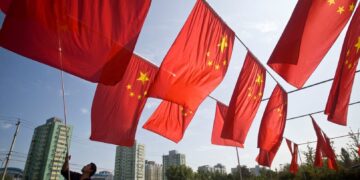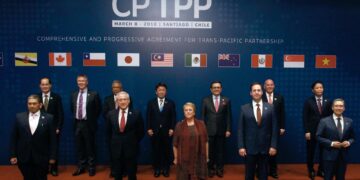When Howard Wu’s son was born in 2009, he celebrated by doing what many proud Chinese fathers do: he broke into his cache of powdered milk formula.
For months before his son’s birth, he had hoarded tins of powder from abroad, adding to his stockpile every time he flew to the United States or Australia on business. Since a 2008 tainted-milk scare killed at least six babies and sickened thousands of others, prices of foreign formula in China have skyrocketed. Some supermarkets in Shanghai—where Wu is a partner at law firm Baker & McKenzie—even keep foreign formula behind glass.
“This is one arena where foreign companies have an edge,” Wu says. “Perception-wise they are viewed as having a higher safety standard [than domestic companies]. Any middle class resident living in a first-tier city will not buy domestic baby formula.”
As a result of food safety concerns and rapidly growing demand, China has become the number one market for US agricultural exports, according to the US Department of Agriculture. In 2012, US agricultural exports to China accounted for $26 billion—or one-fifth—of all US exports to China. Shipments of dairy products grew from $137 million in 2009 to $706 million in 2012, while the value of US soybean exports surged to $13 billion.
But even as exports continue their meteoric climb, American agribusiness firms are eyeing other forms of investment in China. Some are pouring money into livestock production, while others are investing in services like quality control and certification. Still others are seeking local partners for organic production ventures.
“The opportunities are tremendous,” says Eric Trachtenberg, director of the agriculture and food sector at DC consultancy McLarty Associates. “Retail is one, logistics is another… technology to deal with animal waste, irrigation. Anything dealing with food safety would be amazing.”
Domestic demand drives investment, but local supply lags
Chinese consumers are hungry. They are so hungry, in fact, that annual consumption of meat went from 8 million tons in 1978 to 71 million tons in 2012. According to Damien Ma of the Paulson Institute, this means that China now consumes 60 percent more meat than the entire planet did in 1950.
Prior to the 1980s, most of China’s population subsisted on grain-heavy, protein-light diets. But since the country began market reforms in 1978, productivity has gone up, incomes have risen, and almost 700 million Chinese have pulled themselves out of extreme poverty. China’s urban middle class is demanding more safe, high-quality foods like milk, eggs, fish, and organic fruits and vegetables. Increased demand for meat and milk has fueled demand for feed grains like soy and corn.
But China’s domestic supply has been unable to keep pace with demand. The use of modern harvesting equipment and chemical fertilizers, the massive expansion of irrigation systems, and the adoption of American-style industrialized animal feeding operations have pushed China’s agricultural productivity up 3-4 percent every year since 1978. This rate is almost double the world average, but it is still not enough to feed China’s 1.35 billion.
“Growth has been quite impressive,” says Colin Carter, an expert on Chinese agriculture and director of the Giannini Foundation of Agricultural Economics at the University of California, Davis. “But when you dig down, you realize it’s the result of a very intensive use of chemicals, fertilizer, pesticides. You realize that growth has come at a price.”
According to the Food and Agriculture Organization (FAO) of the United Nations, nearly 20 percent of China’s arable land is polluted. Dropping water tables have turned fields into deserts, and almost 40 percent of China’s arable land is degraded from erosion and soil acidification. Soil acidification alone is so bad that it could “cripple” Chinese production in coming years, according to leading Chinese scientists.
Add to that the difficulty of producing large-scale yields on small-scale plots—the average farm size in China is less than two acres compared to 450 acres in the United States—and imports seem to be the logical solution.
But two things have prevented a complete opening to foreign imports. China’s policy of self-sufficiency in grain production, rooted in the famines of the 1930s and 40s, remains a tenant of the country’s national security strategy. According to the Ministry of Agriculture, China’s 2014 goal is to produce 95 percent of “staple grains”—such as wheat, rice, and corn—on its own.
At the same time, policymakers’ desire to promote social stability and economic growth in the countryside has fueled the expansion of China’s agricultural support programs. Since 2008, subsidies and other direct payments to Chinese farmers have increased dramatically, as have the size of government purchasing plans for cotton, corn, and soy. In 2012, China said it spent $75 billion on all agricultural support programs.
Adapting to market restrictions
Since China’s accession to the World Trade Organization in 2001, US agricultural exports to the country have increased 16-fold, from $2 billion in 2000 to $26 billion in 2012. But tariff rate quota levels—or the amount of imports permitted before higher-rate tariffs kick in—have not increased for most agricultural commodities. China’s 2003 ban on US beef imports, a relic of the mad cow disease scare, remains in place as well.
And China’s Catalogue Guiding Foreign Investment—the chief set of rules for companies investing in China—hasn’t loosened for foreign agribusiness firms in recent years. The 2011 revised catalogue instead introduced new restrictions to foreign investment in seed production, grain logistics and storage, and oilseeds and corn processing. For the first time, the catalog banned foreign firms from engaging in domestic agricultural biotech research and development. This is the latest iteration of a longstanding ban on foreign investment in China’s agricultural biotech research sector.
These bans have led to new investment strategies for American companies like Monsanto, the world’s leading producer of genetically engineered seed, and Cargill, one of the world’s largest agricultural commodities traders. Cargill—which has quintupled its investment in China over the last decade—has tailored its global purchasing to genetically modified crops already approved in China. The firm has also significantly expanded its presence in China’s animal feed and poultry production sectors.
In 2012, for example, Cargill opened an integrated poultry complex in Anhui that should process almost 65 million chickens when it reaches full production capacity in 2015. From the beginning, the strategy was to create a vertically integrated supply chain covering feed production, chicken breeding, egg hatching, chicken raising, and poultry processing, says Christopher Langholz, president of Cargill Animal Protein China.
But getting the land use and other required permits introduced “a lot of complexity,” says Langholz, without offering details. So did finding human resources to staff up Cargill’s new feedmill, hatchery, dozens of farms, and multiple processing plants.
Despite the complexity, Cargill plans to open another poultry processing plant this summer.
“No other market can compare with China in terms of the speed of economic growth, the changes in the reduction of poverty, and the diversity and sheer size of markets. These market dynamics all add up to very exciting opportunities for US agribusiness,” says Robert Aspell, president of Cargill China. “We are excited about China’s continued possibilities, but we must also note that conducting our operations in this market is not easy. China is likely one of the most competitive markets we play in.”
Local competition ramps up and reaches out to foreign firms
Backed by government support, state-owned giants like China National Cereals, Oils and Foodstuffs Corp. (COFCO) are seeking to become direct competitors to Cargill and other multinational commodities traders. In February, COFCO announced it was acquiring a 51 percent stake in Dutch grain trader Nidera for $1.3 billion, and in early April, said it would purchase a 51 percent stake in the agribusiness arm of Noble Group Ltd for $1.5 billion.
COFCO’s recent moves—part of its $10 billion overseas investment strategy—are also part of a larger trend of Chinese investment in global agriculture. Encouraged by its government to “go out” and invest in foreign agribusiness properties, private firms like New Hope Group and Shuanghui International have signed overseas deals that continue to grow in number and value. Shuanghui’s $4.7 billion acquisition of US pork producer Smithfield in 2013, for instance, has gone down as the largest-ever Chinese takeover of an American firm.
But most Chinese agribusiness companies are concerned with domestic production and supply chain issues. For example, Tang Zhong, CEO of small-scale organics producer and distributor Okliang says his company’s biggest challenge is scaling up to build a reliable, controllable production and transport chain.
He says that foreign agribusiness can play a role providing production and management techniques, while companies like his can provide access to land—impossible for foreign firms to obtain on their own—and local markets. “Both sides can cooperate to improve the promotion and opening of China’s eco- and organic markets, [at the same time] resolving growing anxieties about China’s domestic food safety,” Tang says in an email.
Food safety is one reason more Chinese agribusiness firms are looking for foreign partners. International distribution networks and access to financing are others. As for foreign firms, most seeking partnerships are interested in the market access that only local companies can provide: access to land, access to local officials, and access to markets in difficult-to-penetrate third- and fourth-tier cities.
“In the last few years, the focus is on acquisitions rather than organic growth,” says Wu of Baker & McKenzie. For foreign companies, “it’s not difficult to find a target. It’s difficult to find a good target.”
In part to help Chinese companies establish themselves as “good targets,” Edward Zhu last year organized a three-day agribusiness symposium for more than 75 Chinese agribusiness CEOs in Shanghai, in coordination with the UC Davis Graduate School of Management. Zhu, himself the CEO of a China-based agribusiness and supply chain management consortium called the CHIC Group, says he wanted to provide Chinese firms with the technological, supply chain, and marketing know-how to make their brands stand out in a highly competitive sector.
“China is in a transition from small-scale farming to large-scale farming. All of a sudden we have found that talent for large-scale, technology-based farming has become a bottleneck,” says Zhu, who adds that the lack of a good system for agribusiness management education is hurting Chinese companies, including his own.
Through future symposia focusing on supply chain management, HR, finance, marketing, and sales, Zhu hopes to build up a cadre of talented Chinese CEOs who will be better able to manage productive agribusiness operations on a competitive world market.
But solving the problems of talent, technology, and even food security come second to the “very, very big-picture questions,” UC Davis’ Carter says. “Land reform, self-sufficiency, pollution—these are the big problems that have to be worked on first.” In the meantime, Carter says that companies will continue to do what they do best—devise new ways to turn a profit.
[author] Catherine Matacic ([email protected]) is the associate editor of the China Business Review. [/author]




























